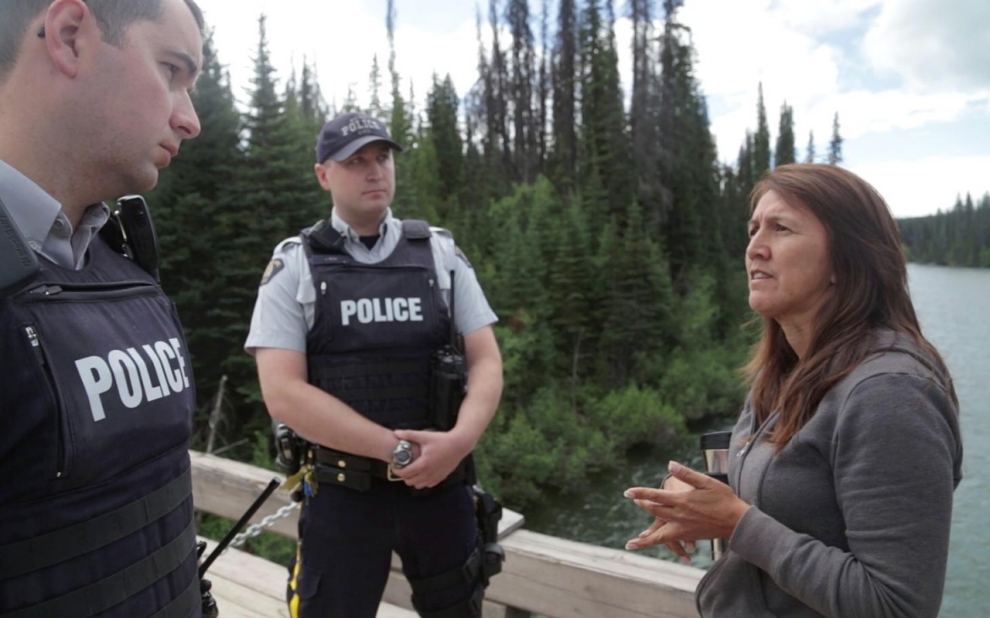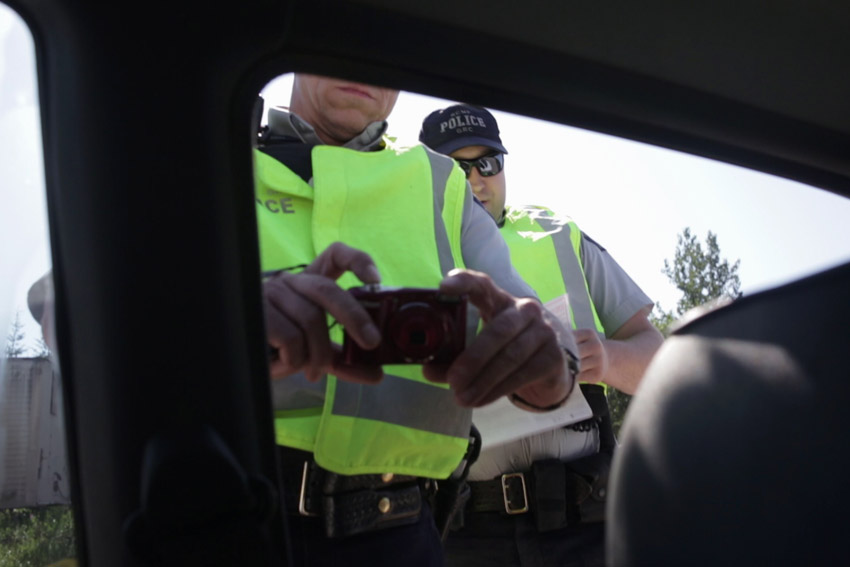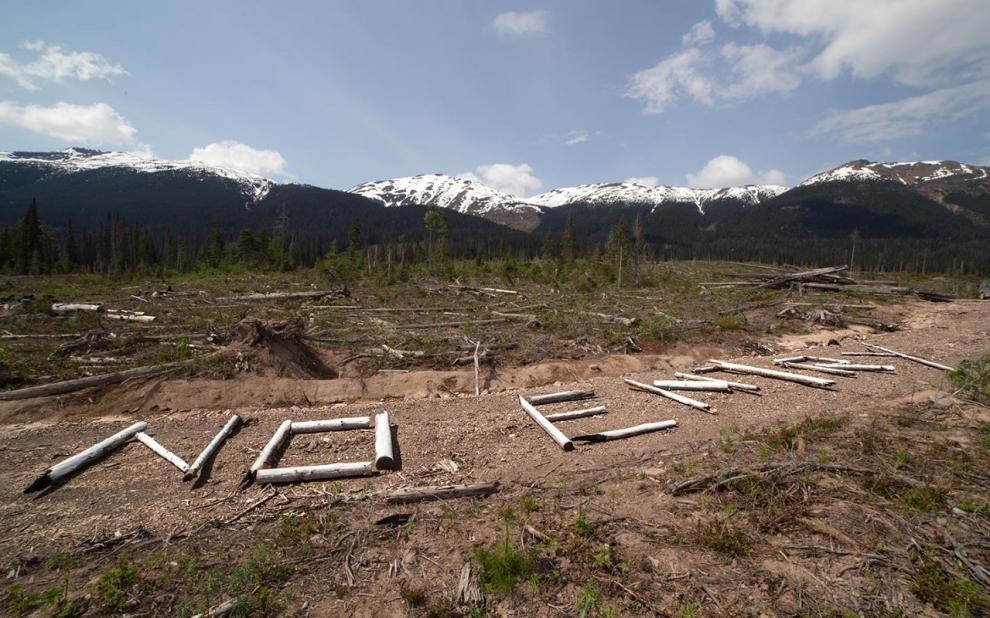To stop oil projects from moving forward, the Unist’ot’en have set up an encampment on traditional territory
Originally published August 20, 2015, in Al Jazeera America
HOUSTON, British Columbia — In a remote mountain pass connecting the Pacific Coast to the interior of British Columbia, a region brimming with wild berries and populated by grouse and grizzly bears, felled and painted trees have been laid across a logging road to form an enormous message. Directed at air traffic, it reads “No pipelines! No entry!” The warning marks off land where the government of Canada and a First Nations clan hold irreconcilable views of what should happen to a 435-square-mile area each claims as its own.
Starting in 2009, the government of Canada began to issue permits for a pipeline corridor to link British Columbia’s fracking fields and Alberta’s tar sands with export facilities and tankers on the Pacific coast. Seeking to become a global energy superpower, Canada staked its economic future and legislative agenda on the rapid expansion of its resource and fossil fuel sectors, envisioning pipelines as the arteries of trillion-dollar hydraulically fractured gas and bitumen industries.
That year the Unist’ot’en clan of the Wet’suwet’en nation began to establish a permanent community directly in the path of three approved projects — Enbridge’s $6.1 billion Northern Gateway, Chevron’s $1.15 billion Pacific Trail Pipeline and TransCanada’s $3.7 billion Coastal GasLink. These pipelines were to run through land that Unist’ot’en were forced from in the early 1900s, and after reoccupying the territories, the clan banned all pipelines under a hereditary governance system that predates Canada.
Although the Unist’ot’en clan, along with most other First Nations peoples in British Columbia, never relinquished its territories to Canada by way of treaty, land sale or surrender, the provincial and federal governments assert jurisdiction over these lands and have authorized widespread development. While the government maintains that First Nations must be consulted about development — though they ultimately lack veto power — by controlling access to their traditional territories, the Unist’ot’en clan is attempting to require that the government gain “consent for any activities and development that take place,” as the clan put it in an Aug. 6, 2015, declaration.
“The Unist’ot’en do not recognize or honor any permits by provincial or federal regulatory or governing bodies related to our unceded traditional territories,” read a letter sent by the clan to pipeline giant TransCanada. “We honor only our traditional law and are guided by our ancestors’ direction to protect our territories from destruction.”
Since June, the hereditary chiefs of the Unist’ot’en clan and dozens of supporters have physically impeded the Royal Canadian Mounted Police (RCMP) and TransCanada and Chevron pipeline work crews from entering the territory. Although the pipeline companies have modified their projects to skirt the Unist’ot’en’s main encampment, they remain intent on building through land traditionally used by the clan.
Rejecting this prospect, the Unist’ot’en have fortified their perimeter. With heavy chains, a pickup truck, a newly installed plywood and barbed wire gate, spotlights and an emergency siren, the clan transformed a bridge to their traditional territory into an international border, monitored by a fluctuating crew of volunteer guards.

In the past three months, a series of encounters with pipeline companies and law enforcement officials have occurred at checkpoints on logging roads that lead to the clan’s traditional territories. To access these roads, visitors are required to answer five questions posed by a clan representative: “Who are you?” “Where are you from?” “Do you work for industry or government that’s destroying our land?” “What skills do you bring?” and “How will your visit benefit the Unist’ot’en?” The protocol is inspired by the U.N. Declaration on the Rights of Indigenous Peoples and by the clan’s history of monitoring its territorial boundaries and enforcing trespass laws.
Though loggers, tree planters and a guide outfitter have been granted access to the territory since the clan instituted this protocol, pipeline contractors have been turned away. Throughout June, safety officers and TransCanada crew members, some wearing body cameras, repeatedly approached the boundary and asked camp supporters their names and if crews would be in danger if they entered the territory. Clan members believe that energy companies are gathering information to obtain a court injunction, which would oblige police to force the roads open in order to ensure that pipeline crews can work unimpeded.
On two occasions, helicopters carrying TransCanada crews were found entering the traditional territory without permission. The first crew was confronted by Unist’ot’en supporters and immediately complied when asked to leave. The second crew, escorted by an ex-military pilot and security staff, completed a day of work before volunteers grounded their helicopter by staging a sit-in beneath its rotor blades.
At the end of July, representatives of the Chevron-backed Pacific Trail Pipeline arrived at the Unist’ot’en boundary. “We’re here to talk to you about doing work on your land and are requesting access onto your territory,” said pipeline vice president Rod Maier.
“We’ve already written you letters saying that you guys don’t have our consent,” Freda Huson, a spokeswoman for the clan, replied. “We’re not letting the last stitch of our land be taken over so we can’t hunt, fish and trap or teach our young ones who they are and where they belong.”
Huson’s home, a cabin built five years ago in the path of Enbridge and Chevron’s projects, has transformed into a base of operations for the northwestern anti-pipeline movement. Pipeline maps sprawl across her living room table, two-way radios and scanners bleat updates from remote outposts throughout the territory, and quarters of bear meat are canned in her kitchen. Her front door swings open and shut as a steady stream of activists from across North America and beyond rush in and out to grab supplies.
Outside the cabin, a community thrives in the pipelines’ paths. A permaculture garden, a solar-powered electric grid, a bunkhouse, elders’ trailers, campgrounds, a root cellar, a traditional Wet’suwet’en pithouse and a two-story healing center with an industrial kitchen and counseling space have all been built with crowd-sourced funds and volunteer labor.
Zeroing in
As pipeline crews have increased their presence throughout the region, so too have the RCMP. In late June, police initiated what the clan called “a campaign of harassment and intimidation on and around Unist’ot’en territory.” Two police checkpoints were established on roads used by the Unist’ot’en under the pretense of ensuring safety.
For approximately two weeks, officers asked drivers and passengers traveling in the region for identification and information about their travel plans. The driver of a vehicle associated with the Unist’ot’en was stopped and questioned in a nearby town.
Some American tourists visiting the Unist’ot’en reported that they were stopped four times by RCMP officers and warned that they could be criminally charged, deported and banned from Canada if their vehicle was found impeding road access. The British Columbia Civil Liberties Association expressed concern in a letter to police that “the sudden and repeated presence of mandatory checkpoints at this location has the appearance of targeting people who are lawfully traveling to and from the camp.”
“This is Unist’ot’en territory. It’s not Canada. It’s not [British Columbia]. We make our own laws here.” – Freda Huson, Unist’ot’en spokesperson
Brett Rhyno, a longtime supporter of the clan, was stopped three times by police in two hours.
In the first stop, an officer rested his hands in the vehicle and indicated that he had prior intelligence on Rhyno. At the next, officers pointed a camera into the vehicle and photographed me in the backseat. I was asked to identify myself but declined, in compliance with Canadian law. At the final stop, officers asked me to identify myself again. When I remained silent, officers identified me by name, without having been provided my personal information.

“They were using scare tactics to try and scare our supporters away,” Huson said. “It worked a bit.”
Several weeks later, two officers of the RCMP attempted to cross into Unist’ot’en territory and were stopped by clan supporters. Blocked by a volunteer who repeated, “You do not have jurisdiction to walk through here,” Sgt. Steve Rose of the Houston RCMP insisted, “Yes, I do,” and threatened to make arrests. “The RCMP have access to all of Canada to enforce the laws of Canada,” he told Huson.
“This is Unist’ot’en territory. It’s not Canada. It’s not B.C.,” Huson replied. “We make our own laws here.”
Surveilling First Nations

On Aug. 7, a suspicious person was removed from the Unist’ot’en encampment for taking photos and video without permission — the third time that the clan has suspected a police infiltrator among their supporters.
Police attention to the community dates back to at least 2010, when direct action workshops held by the clan were subject to RCMP surveillance. An RCMP intelligence report from September 2011 devotes a section to the Unist’ot’en.
More broadly, the RCMP has monitored First Nations and environmental groups at hundreds of protests, on the Web, with drones and through the use of field agents or spies. Police investigated a 71-year-old woman as a terrorist threat after she took photos of a petroleum storage facility in Vancouver. They violently dismantled an indigenous anti-fracking blockade in Elsipogtog, New Brunswick. And last year they made over 100 arrests on Burnaby Mountain, where members of the public used civil disobedience to resist the construction of a tar sands pipeline.
RCMP officials have held regular meetings with energy corporations and granted industry representatives security clearance and access to classified information. A report prepared for the petroleum industry by the RCMP’s critical infrastructure intelligence team, deemed activists with “anti-petroleum ideology” a “realistic criminal threat to Canada’s petroleum industry, its workers and assets and to first responders.”
In the report’s appendix, an article on the Unist’ot’en published in British Columbia’s Georgia Strait is reproduced in full. Summarizing threats to the Enbridge Northern Gateway, a project that the Unist’ot’en community obstructs, the report reads, “The [second] most urgent anti-petroleum threat of violent criminal activity is in northern British Columbia, where there is a coalition of like-minded violent extremists who are planning criminal actions to prevent the construction of the pipeline.”
“They’re trying to categorize us as violent extremists so they can legitimize what they’re doing, so they can try and force their projects through here,” Huson argued. “The RCMP are there to enforce the government’s permits, even though they’re illegal.”
Since the clan issued a call for support on July 19, reinforcements and supplies have arrived daily. Helicopters and low-flying planes have conspicuously circled the camp and photographed its occupants. In Toronto, Montreal, Vancouver, Victoria and Seattle, activists have dropped banners, occupied investors’ offices and held rallies in solidarity with the Unist’ot’en. At a Montreal rally, police arrested one protester and fined eight others for obstructing a roadway.
Despite being on high alert, over a long weekend in honor of British Columbia, the Unist’ot’en and their supporters sang and danced to celebrate Knedebeas Day — a holiday named for a clan head chief who instructed her grandchildren, “Let no man take this land.”
They ate wild salmon pizza from a wood-fired oven and drank river water as kids played on a teeter-totter made of 2-by-4s. Elders cleaned buckets of huckleberries, and a warrior sat by the campfire sharing stories from Kanehsatake and Gustafsen Lake — armed standoffs in which Canada used military force against indigenous activists asserting their sovereignty.
On the other side of the border, Chevron crews and security teams move closer to the Unist’ot’en every day as they conduct studies and survey for a pipeline right of way. Yet, aside from the distant whir of helicopters and the occasional siren of an emergency preparedness drill, the community lives quietly, in peace.